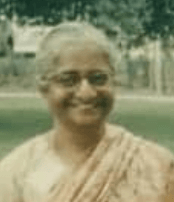Ayyalasomayajula Lalitha facts for kids
Quick facts for kids
Ayyalasomayajula Lalitha
|
|
|---|---|

A. Lalitha, photographed in 1964 in New York.
|
|
| Born | 27 August 1919 |
| Died | 1979 |
| Nationality | Indian |
| Occupation | Engineer |
Ayyalasomayajula Lalitha (born August 27, 1919 – died October 12, 1979) was a pioneering Indian engineer. She made history by becoming India's very first female engineer.
Contents
Early Life and Education
Ayyalasomayajula Lalitha was born in Madras (which is now called Chennai) on August 27, 1919. She came from a family that spoke the Telugu language.
When she was 15, Lalitha got married. In 1937, she had a daughter named Syamala. Sadly, her husband passed away just four months later. Her father, Pappu Subba Rao, was a professor at the College of Engineering, Guindy (CEG). He strongly supported Lalitha's wish to finish her schooling and study engineering.
Studying Engineering
Lalitha joined CEG, which was mostly for male students at the time. She was one of the first women to study engineering there, alongside other brave women like P.K. Thressia and Leelamma Koshie.
Her daughter, Syamala, shared that the college and its students were very supportive of Lalitha. Even though she was the only girl among many boys, no one made her feel uncomfortable. The college even arranged a special hostel just for her.
In 1943, Lalitha graduated with a degree in electrical engineering. This made her India's first woman engineer! After graduating, she completed a year of hands-on training. She worked at the Jamalpur Locomotive Workshop, which is a big facility for repairing trains.
Engineering Career
After her training, Lalitha worked at the Central Standards Organisation in Shimla. She helped her father with his research on special "smokeless ovens" and an electrical musical instrument called the jelectromonium.
She then spent a year gaining practical experience in the electrical department of the East Indian Railways. Later, she became a technical assistant in the Indian Government’s Office of the Electrical Commissioner.
Working on Big Projects
In 1948, Lalitha joined a British company called Associated Electrical Industries (AEI) in Calcutta. She worked on a very important project: the Bhakra Nangal Dam, which is one of the largest dams in India. Her job involved designing the power lines that carry electricity and planning the layouts for substations.
Lalitha worked at AEI for almost 30 years. The company was later taken over by General Electric Company. She retired in 1977.
International Recognition
In 1953, a group called the Institution of Electrical Engineers (IEE) in London made her an associate member. They promoted her to a full member in 1966.
Lalitha was the only female engineer from India to attend the First International Conference of Women Engineers and Scientists (ICWES) in New York in 1964. This was a big event where women engineers from around the world met.
In 1965, she became a member of the British Women's Engineering Society. She also helped organize the Second International Conference of Women Engineers and Scientists (ICWES) in Cambridge in July 1967. Thanks to her efforts, five women engineers from India were able to attend this important conference.
Personal Life
Lalitha chose not to remarry after her husband passed away. She lived with her sister-in-law for most of her life. Her sister-in-law helped raise Lalitha's daughter, Syamala. Syamala went on to study science and became a mathematics teacher.
In 1979, Lalitha sadly passed away at the age of 60 due to a brain aneurysm.

